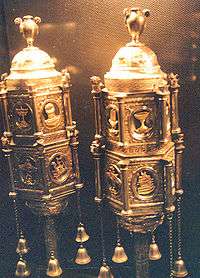Great Synagogue of Rome
| Great Synagogue of Rome | |
|---|---|
 | |
| Basic information | |
| Location | Rome, Italy |
| Affiliation | Orthodox Judaism |
| Rite | Italki and Spanish[1] |
| Status | Active |
| Website | tempiomaggiore.roma |
| Architectural description | |
| Architect(s) |
Vincenzo Costa Osvaldo Armanni |
| Completed | 1904 |
The Great Synagogue of Rome (Italian: Tempio Maggiore di Roma) is the largest synagogue in Rome.
History
The Jewish community of Rome goes back to the 2nd century B.C when the Roman Empire had an alliance of sorts with Judea under the leadership of Judah Maccabeus. At that time, many Jews came to Rome from Judea. Their numbers increased during the following centuries due to the settlement that came with Mediterranean trade. Then large numbers of Jews were brought to Rome as slaves following the Jewish–Roman wars in Judea from 63 to 135 CE.[2]
The present Synagogue was constructed shortly after the unification of Italy in 1870, when the Kingdom of Italy captured Rome and the Papal States ceased to exist. The Roman Ghetto was demolished and the Jews were granted citizenship. The building which had previously housed the ghetto synagogue (a complicated structure housing five scolas (the Italian-Jewish term for synagogues) in a single building was demolished, and the Jewish community began making plans for a new and impressive building.[3]
Commemorative plates have been affixed to honour the local Jewish victims of Nazi Germany and of a Palestine Liberation Organization attack in 1982.
On 13 April 1986, Pope John Paul II made an unexpected visit to the Great Synagogue. This event marked the first known visit by a pope to a synagogue since the early history of the Roman Catholic Church. He prayed with Rabbi Elio Toaff, the former Chief Rabbi of Rome.[3][4] This was seen by many as an attempt to improve relations between Catholicism and Judaism and a part of Pope John Paul II's programme to improve relations with Jews. In 2010 Rabbi Riccardo Di Segni hosted a visit from Pope Benedict XVI,[5] while Pope Francis visited the synagogue on 17 January 2015.[6]
The synagogue celebrated its centenary in 2004. In addition to serving as a house of worship, it is also serves a cultural and organizational centre for la Comunità Ebraica di Roma (the Jewish community of Rome). It houses the offices of the Chief Rabbi of Rome, as well as the Jewish Museum of Rome.[3][7]
On 17 January 2005, thirteen cantors, in conjunction with the Jewish Ministers Cantors Association of America (the Chazzanim Farband), performed in a cantorial concert for the first time in the synagogue's history.
Pope Francis visited the Great Synagogue on 17 January, 2016. During his visit, the pope denounced all violence committed in the name of God, and joined in the diaspora as a sign of interfaith friendship. Pope Francis repeated several times the words first spoken by Pope John Paul, saying that Jews were the "elder brothers" of Christians. Pope Francis added Christian "elder sisters" of the Jewish faith to his words.[8]
1982 Great Synagogue of Rome attack
The synagogue was attacked on 9 October 1982 by armed Palestinian militants at the close of the morning Sabbath service. One person, a toddler, was killed.
Design
Designed by Vincenzo Costa and Osvaldo Armanni, the synagogue was built from 1901 to 1904 on the banks of the Tiber, overlooking the former ghetto. The eclectic style of the building makes it stand out, even in a city known for notable buildings and structures.[3] This attention-grabbing design was a deliberate choice made by the community at the time who wanted the building to be a visible celebration of their freedom and to be seen from many vantage points in the city. The aluminium dome is the only squared dome in the city and makes the building easily identifiable even from a distance.
Gallery
 Silverware on display in the Jewish Museum of Rome
Silverware on display in the Jewish Museum of Rome Inner ornamental embroidered covering of the Scroll of the Law.
Inner ornamental embroidered covering of the Scroll of the Law. Ornamental velvet covering of the Scroll of the Law.
Ornamental velvet covering of the Scroll of the Law. Rings on the Scroll of the Law.
Rings on the Scroll of the Law.
References
Notes
- ↑ http://www.chabadroma.org/templates/articlecco_cdo/aid/708118/jewish/Synagogues
- ↑ "Temple Israel - Jewish & Italian". © 2002-2007, ‘It Won't Byte’ Web Design & Hosting. Retrieved 2008-10-27.
- 1 2 3 4 ""Great Synagogue, Rome"". Sacred Destinations. Retrieved 2008-10-21.
- ↑ "Boston College: "Address at the Great Synagogue of Rome April 13, 1986"". © 2008 The Trustees of Boston College. Archived from the original on 2008-06-11. Retrieved 2008-10-21.
- ↑ http://www.romaebraica.it/wp-content/uploads/2010/12/discorso-rav-di-segni-visita-denedetto-xvi.pdf
- ↑ "Pope Francis makes his first papal visit to Rome synagogue". The Guardian. Retrieved 24 January 2016.
- ↑ Krusch, David. ""The Jewish Museum in Rome"". © 2008 The American-Israeli Cooperative Enterprise. Retrieved 2008-10-21.
- ↑ "Pope visits Rome's Great Synagogue: You are our 'elder brothers' - Jewish World News".
External links
| Wikimedia Commons has media related to Great Synagogue (Rome). |
- (English) Great Synagogue of Rome (Contact, Map, Images and history)
- (Italian) Museum adjacent to Synagogue
- (English) Jewish Rome
Coordinates: 41°53′31.57″N 12°28′40.81″E / 41.8921028°N 12.4780028°E